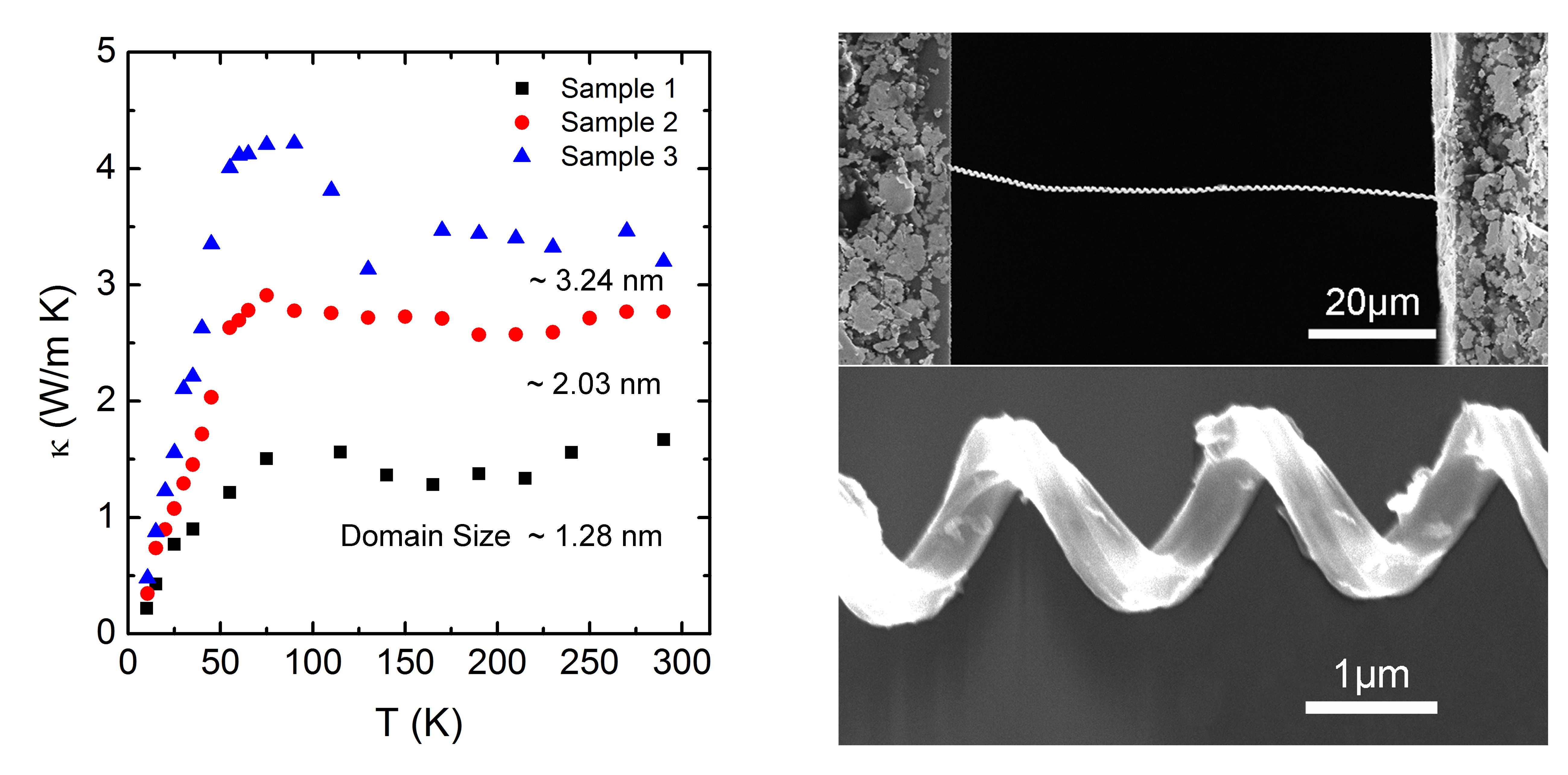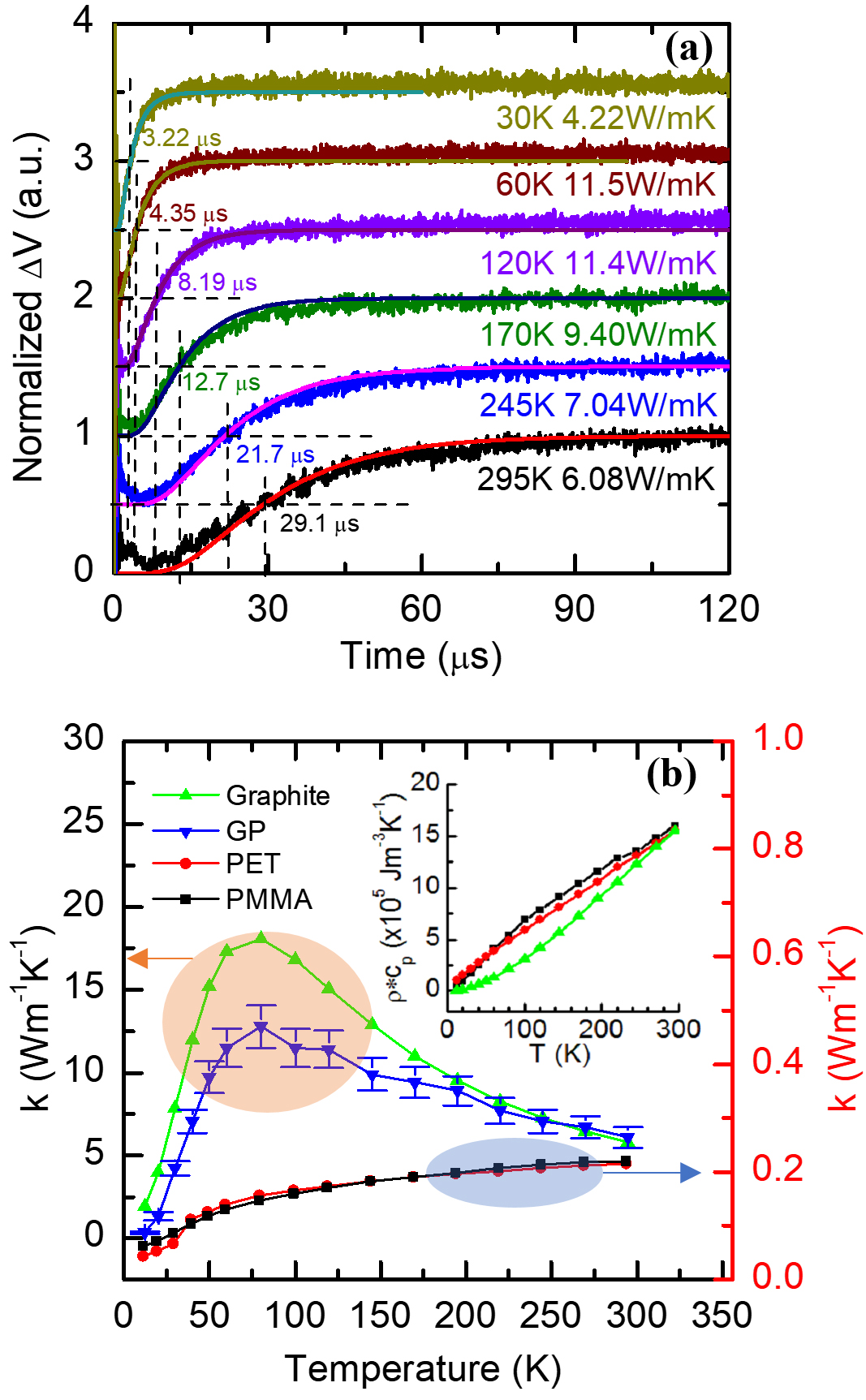|
|
|
Advanced Technology Development for Micro/Nanoscale Thermal Probing and Characterization
Over 20 years our laboratory has been working at the frontier of thermal science to develop various advanced and novel technologies to overcome the great challenges in thermal probing and characterization at the micro/nanoscale. After years of development, now we are enjoying the use of our advanced technologies to 1) Probe the thermal transport along 2-D and 1-D micro/nanscale materials down to tens of nm scale; 2) Characterize the energy transport and contact resistance across zero-dimensional materials (one single point); and 3) Measure thermophysical properties of micro/nanoscale films and interface thermal resistance. "Physically straight-forward and experimentally easy to implement" is of paramount importance in our new technology development.
Below lists some of the critical techniques invented by our lab and their capabilities.
1. Transient electro-thermal (TET) technique This technique is capable of measuring the thermal conductivity, thermal diffusivity, and specific heat of materials down to sub-nm thickness. Due to its great advantages over many other techniques, now this technique is almost a golden standard and being used in our lab for daily and advanced thermal science research. Also it is being adopted more and more world-wide for characterizing thermophysical properties of fibers/films.
Fig. 1: Carbon nanocoil measured using our TET technique down to 10 K.
2. Transient photon-electro-thermal (TPET) technique This technique involves modulated laser heating and electrothermal sensing to realize fast thermal diffusivity measurement. With the fast development of laser modulation technology, the TPET technique can realize ~ns scale thermal characterization and localized thermal diffusivity mapping of free standing wires and films.
3. Optical heating and electrical thermal sensing (OHETS) technique This technique employs a laser modulated at selected frequencies to heat up the sample, and measuring its voltage/resistance/temperature variation (amplitude and phase shift). It is superior to the self-heating 3w method in terms of conduction and measurement accuracy.
4. Pulse laser-assisted thermal relaxation (PLTR) technique and PLTR2 In this technique, the sample is exposed to a pulsed laser for instantaneous heating (~ns to ps), and its temperature decay is probed by measuring its electrical resistance/voltage. PLTR is for measuring the thermal diffusivity of fibers/films in the in-plane direction. The second generation (PLTR2) has extended the capacity to measure the thermal diffusivity in the thickness-direction of microscale thick films. PLTR2 could provide critical and accurate information about the anisotropic thermal diffusivity/conductivity of materials.
Fig. 2: (a) us thermal response measured in our PLTR2 technique for the thickness direction thermal transport of graphene paper (~30 um thick), (b) c-axis thermal conductivity of graphene paper down to 10 K to show the phonon boundary scattering effect.
5. Time-domain differential Raman (TD-Raman) TD-Raman involves heating the sample with a square laser pulse of varied length and probing the thermal response based on evaluating the simultaneously collected Raman signals. It provides a novel way to track the transient thermal response of a micro/nanoscale material and measure its thermal diffusivity.
6. Frequency-resolved Raman (FR-Raman) FR-Raman has a laser beam modulated at different frequencies for both heating and Raman signal excitation. It has the same advantage as the TD-Raman for measurement capability, but needs a very short time of data collection for micro/nanoscale scale heating and probing.
7. Energy transport state-resolved Raman (ET-Raman) The ET-Raman technique probably represents one of the most advanced Raman techniques for measuring interface conductance, thermal conductivity, hot carrier diffusivity, etc. It tracks the transient response of a material down to ps scale, yet features ultra accuracy. It takes a strategy for ultrafast thermal probing that is completely different from the pump-probe method.
8. Frequency domain ET-Raman (FET-Raman) The FET-Raman technique constructs different energy transport states in the frequency domain, different from the time domain in ET-Raman. It features great ease of implementation, and like the above Raman techniques, does not need the knowledge of laser absorption and absolute temperature rise in thermophysical properties measurement. This completely overcomes the physical problems (localized stress, optical interference, sample rippling) faced in normal steady state Raman-based thermal characterizations.
9. Photothermal (PT) technique This technique has been developed for more than 20 years in our lab for thermal characterization of coatings and free-standing films. It could measure a material's thermal conductivity and interface thermal resistance with high sensitivity, and is very versatile and robust.
10. Differential Thermal Resistance (DTR) technique This technique was developed to provide some of the best measurement of thermal conductivity for microscale materials (in-plane and cross-plane), in air or vacuum. It takes a different way to extract the thermal conductivity information while not requiring exact knowledge of heat flux and temperature drop across the sample.
Remarks: Our lab also has invented several different techniques for in-field thermophysical properties measurement and for macroscale materials measurement.
|


